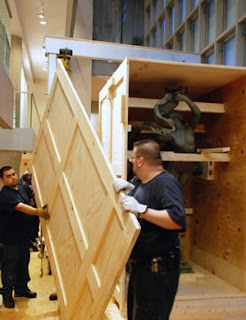 |
| Annie Frances Lee Blue Monday |
Artist Annie Frances Lee was born on March 3, 1935 in Gadsden, Ala. Raised by a single parent, she grew up in Chicago, Ill., and attended Wendell Phillips High School.
Lee began painting at an early age, winning her first art competition at the age of 10. Lee was offered a four-year scholarship to attend Northwestern University after high school, but married instead and raised a family.
It was not until age 40 that Lee decided to pursue a career as an artist. She enrolled in Loop Junior College and completed her undergraduate work at Mundelein College in Chicago.
After eight years of night classes, while working at Northwestern Railroad as a clerk in the engineering department, Lee earned her M.A. degree in interdisciplinary arts education from Loyola University.
Lee’s railroad job inspired one of her most popular paintings, "Blue Monday," which depicts a woman struggling to pull herself out of bed on a Monday morning. Her trademarks are the animated emotion of the personalities in the artwork and the faces which are painted without features.
At age 50, Lee had her first gallery show; she allowed prints to be made of four of her original paintings. Using her unique designs, Lee also developed figurines, high fashion dolls, decorative housewares, and kitchen tiles.
After showing her work in other galleries for a number of years, Lee opened Annie Lee and Friends Gallery where she displayed her works as well as the works of other artists.
When several of her paintings appeared on the sets of popular television shows such as The Cosby Show and A Different World, the exposure helped popularize her work. Although she regularly received requests for public appearances, Lee preferred to appear at gallery shows; she also enjoyed visiting schools to encourage and inspire students.
She passed away on November 14, 2014, at the age of 79.
Source: http://www.thehistorymakers.com/biography/annie-lee-41





